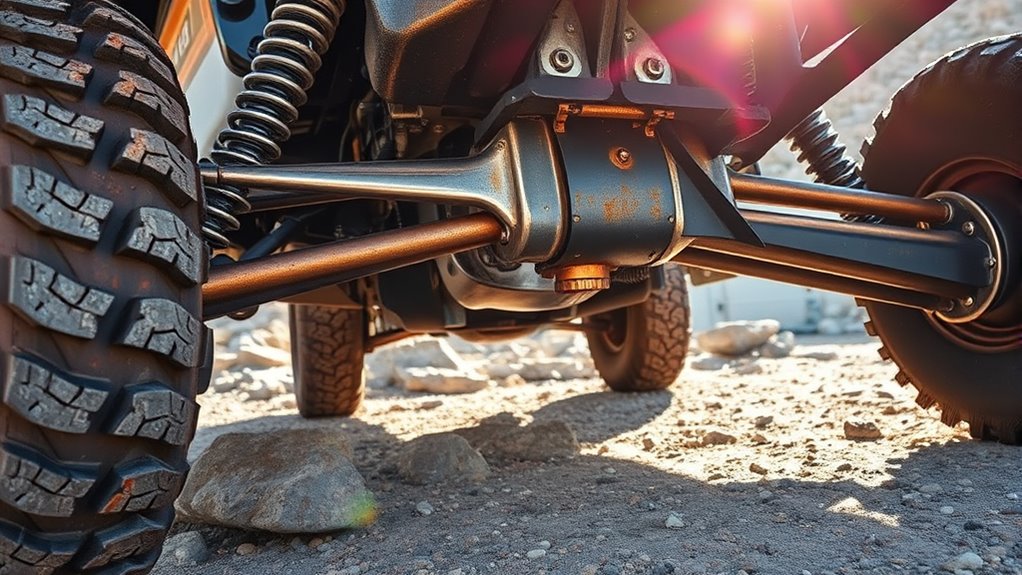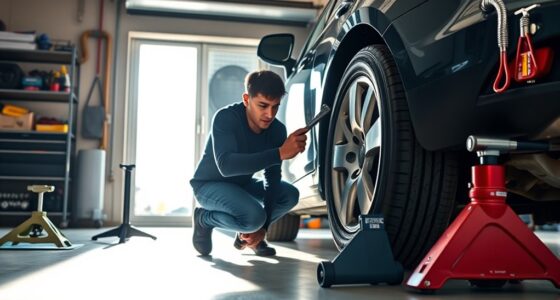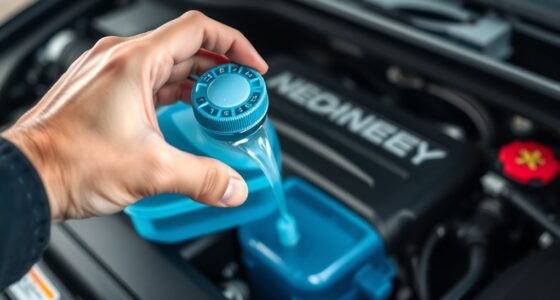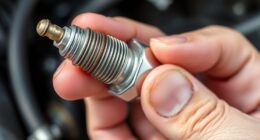To prevent rust and damage on your off-road vehicle, you should clean it thoroughly after each trip, focusing on hard-to-reach areas, and make certain it’s fully dry to avoid moisture buildup. Apply rust-proof coatings or undercoatings regularly, especially after mud or water exposure. Touch up any scratches or chips promptly and keep drain holes clear to prevent water retention. Stay vigilant with maintenance; staying protected helps keep your vehicle in top shape longer, and more tips await if you continue exploring.
Key Takeaways
- Clean your vehicle thoroughly after off-road trips, paying attention to hard-to-reach areas like wheel wells and undercarriage.
- Regularly inspect and reapply rust-proofing or rubberized undercoatings to vulnerable areas for ongoing protection.
- Promptly patch scratches and chips with rust-inhibiting paint or rust converters to prevent rust spread.
- Ensure drain holes and vents are clear of debris to facilitate water drainage and reduce internal rust formation.
- Use rust-inhibitor wax or sprays during off-season storage and after exposure to moisture for added long-term protection.
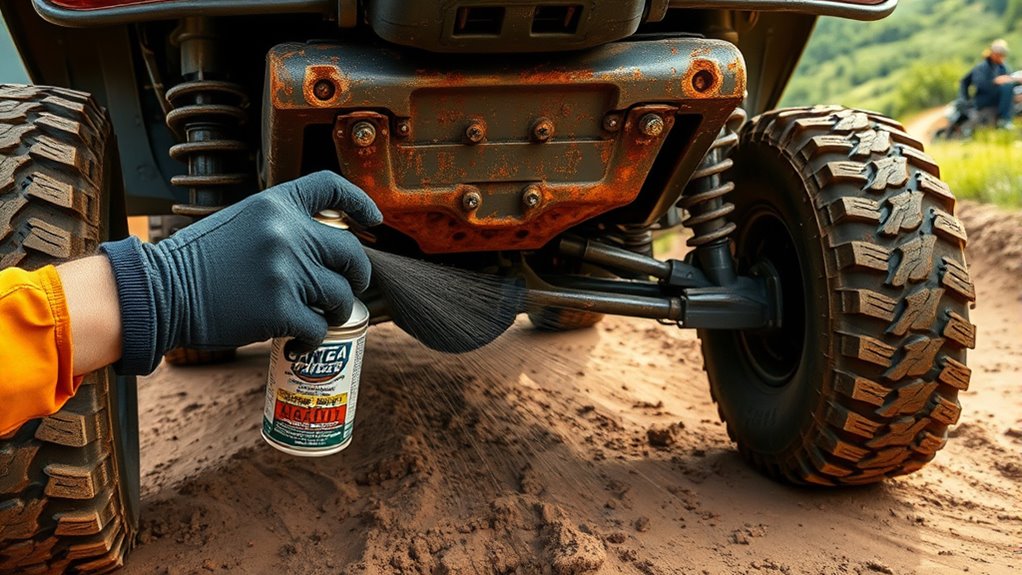
Ever wondered how to keep your off-road vehicle in top shape for those rugged adventures? One of the biggest threats to your vehicle’s longevity and performance is rust, which can quickly weaken the structure and lead to costly repairs. To combat this, rust prevention should be a top priority in your maintenance routine. Start by thoroughly cleaning your vehicle after every off-road trip to remove mud, dirt, and moisture that can trap and promote rust formation. Pay special attention to hard-to-reach areas such as wheel wells, undercarriage, and suspension components. After cleaning, make sure to dry your vehicle completely to prevent any lingering moisture that could accelerate rust development.
Applying protective coatings is one of the most effective ways to prevent rust and shield your vehicle from damage. These coatings act as a barrier, preventing moisture and corrosive elements from making contact with metal surfaces. Consider using a high-quality rust-proofing spray or undercoating, especially on vulnerable areas like the frame and undercarriage. Many off-road enthusiasts opt for rubberized undercoatings, which provide a durable, flexible layer that can absorb impacts and resist chipping. Regularly inspecting and reapplying these coatings ensures continuous protection, especially after exposure to mud, water crossings, or salt.
Beyond coatings, you should also pay attention to your vehicle’s paint job. A fresh coat of paint or a specialized rust-inhibiting paint can add an extra layer of defense. Touch up scratches and chips promptly to prevent exposed metal from rusting. If you notice any signs of rust beginning to form, address it immediately by sanding down the affected area and applying a rust converter or primer before repainting. This proactive approach prevents small rust spots from spreading and causing more extensive damage.
In addition to external treatments, ensure your vehicle’s drain holes and vents are free of debris. These small openings allow trapped water to escape, reducing the risk of rust forming from within. Regularly inspecting and cleaning these areas can save you from future headaches. Also, consider using a rust-inhibitor wax or spray during off-season storage or after heavy exposure to moisture, creating an additional protective layer.
Frequently Asked Questions
How Often Should I Apply Rust-Proofing Treatments?
You should consider applying rust-proofing treatments every 1 to 2 years, depending on your vehicle’s exposure and usage. Regular application frequency helps maintain the treatment’s effectiveness and guarantees longer treatment longevity. If you frequently drive off-road or in harsh environments, more frequent applications may be necessary. Keep an eye on your vehicle’s condition and reapply as needed to protect it from rust and damage, extending its lifespan.
Can Washing With Untreated Water Cause Rust?
They say, “Prevention is better than cure,” and washing with untreated water can still cause rust. Water quality matters—if you use untreated water, minerals and impurities can stick to your vehicle’s surface, promoting corrosion. Regularly washing and drying your off-road vehicle helps with rust prevention. Avoid letting dirt and water sit on your vehicle, especially in hidden spots, to keep rust at bay and preserve its longevity.
What Are the Best Storage Methods for Off-Road Vehicles?
When it comes to storage, you want to keep your off-road vehicle in a garage or covered area to shield it from dirt, moisture, and UV rays. Using a good cover provides extra protection, especially if you can’t store it indoors. Make sure the space is dry, well-ventilated, and clean. Regularly check for any signs of moisture or damage, and consider using desiccants to keep humidity levels low.
How Do Environmental Factors Affect Rust Development?
Environmental exposure profoundly influences rust development by accelerating corrosion mechanisms. Humid conditions, rain, and snow increase moisture on your vehicle’s surface, fostering oxidation and corrosion. Salt from roads or coastal air further intensifies this process. You need to be aware of these factors because they directly impact how quickly rust forms. Protect your off-road vehicle by minimizing environmental exposure, regularly cleaning it, and applying protective coatings to slow down these corrosion mechanisms.
Are There Specific Products Recommended for Rust Removal?
When it comes to rust removal, you’re in the driver’s seat. You should look for products like rust converters and corrosion inhibitors, which are specifically designed to restore and protect your vehicle. Rust converters turn rust into a stable compound, while corrosion inhibitors provide a protective barrier. Using these products guarantees you’re fighting rust effectively and extending your off-road vehicle’s lifespan. Don’t wait until it’s too late—take action now.
Conclusion
Keeping your off-road vehicle rust-free and protected isn’t just about looks; it extends your ride’s lifespan. Did you know that vehicles exposed to salty environments can rust up to 75% faster? Regular cleaning, applying sealants, and inspecting for damage keep corrosion at bay. By staying proactive, you’ll save money and enjoy more adventures. Don’t wait for rust to take over—take charge now and keep your off-road beast in top shape for years to come.
